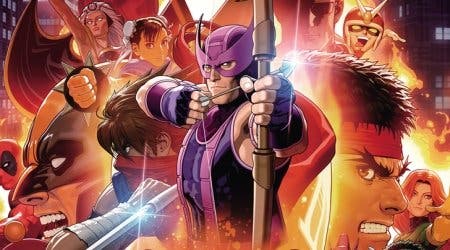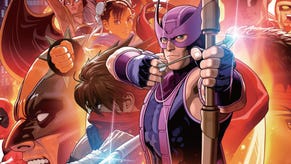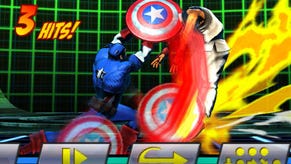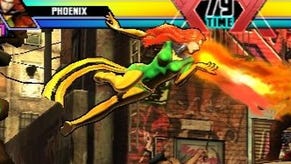Ultimate Marvel vs. Capcom 3 Review
The Weapon X Factor.
A couple of months before the less ultimate version of Marvel vs. Capcom launched, a few colleagues and I were given extensive access to a preview build that was lacking in the usual command lists and training modes, but as a bare-bones taster of what was to come, allowed us to experiment with the fresh combat system without any prior guidance. We were simply presented with a colourful select screen and tasked with figuring out the many technical nuances for ourselves.
This began with a self-set mission to find each character's full repertoire of special moves and hyper combos, which, after a lot of perseverance, led to us discovering Dante's sneaky teleport, Amaterasu's multiple weapon stances and X-23's level three hyper - which despite looking like it just turned her invisible, opened up a highly damaging throw. The focus then moved on to building effective team combinations with assists that covered individual weaknesses, while opening up nasty set-ups and extended combo opportunities. But as pleased as we were with our humble efforts, the real revelations came after the game's release.
There were off-the-bat X-Factor combos that could kill a character in the first few seconds, tricky shenanigans like Magneto's Hyper Gravitation loop and the infamous DHC glitch, which let you reset damage scaling and hit stun. Or at least it used to, as Capcom have removed it from Ultimate Marvel vs. Capcom 3. And yet, despite a lot of nips, revisions, tucks and additions, the one thing that hasn't changed is that unrivalled sense of experimentation that compels you to push your most impressive combo that one step further.

Those who immediately pick their old team rather than experimenting with the new characters (booo!) will find that some minor, and some more substantial changes have been made to the returning cast. Ryu, for instance, has changed dramatically with new chargeable specials and a power-up technique that makes his Hadoken hyper bounce off the wall and turns his Hurricane Kick hyper into a whirling vortex complete with lightning bolts. His overhead punch will now also cancel into his special moves, dramatically improving his ability to catch opponents off guard for solid damage.
Other character-specific changes - and there are many - include Amaterasu changing her stance midair; a new Impact Punch for Hulk that can be charged and causes a wall bounce; new distance spacing tools for Storm and Magneto that let you push the opponent back or draw them in; and a revised Raging Demon for Akuma that lets you mash the buttons for in excess of 40 hits. And in the interest of balance, Sentinel now has a harder time comboing into a Hyper Sentinel Force off a Rocket Punch, while Phoenix can no longer spam fireballs in the air.
But Ultimate's main attraction is the roster of 12 new characters that it parades during the opening sequence. Out of all of these, it's the bemusing addition of the Ace Attorney himself, Phoenix Wright, which stands out the most, and although it initially seems like he's a joke character along the lines of Dan or Norimaro, it quickly becomes apparent that he's capable of some impressive combos with his quirky stances that have him searching for clues in Investigation Mode, before administering some rough justice in Turnabout Mode.
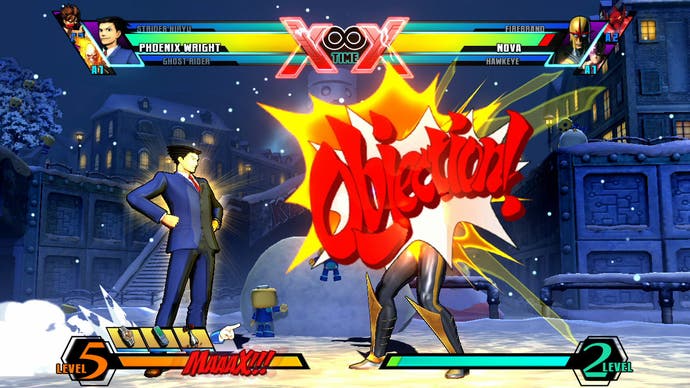
Also on the Capcom guest list is the zombie-slaying Frank West from Dead Rising. This represents Frank's second time in a Vs. game, but compared to his Tatsunoko vs. Capcom appearance, he fights very differently in Ultimate. This is due to a levelling-up system that lets him improve his offensive hardware from weedy plungers and golf clubs to spiked bats, sledgehammers and even double-bladed chainsaws by taking photos. Nemesis also makes a less talkative appearance with moves that include a command grab, an effective ground bounce and a launcher with huge range - in both the vertical and rocket sense. The simplicity of his devastating combos also makes him a viable alternative for Sentinel players.
But it's not all about the lawyers, journalists and tyrants as Marvel has made an equally strong showing with the likes of Rocket Raccoon and Doctor Strange. The furrier of the two plays a complex zoning game where he deploys traps that come in bear, net, log, claymore and landmine flavours, while the stranger of the two - or perhaps that should be the more mystical - is a master of complex projectiles with everything from defensive electrical spheres to the ability to conjure orbs that can be detonated from a distance. He can even teleport on a medallion-stroking whim.
Welcome changes have also been applied to the underlying combat system. This includes a less overbearing X-Factor mechanic that can now be activated mid-air, as well as a revised Aerial Exchange that lets you drain the opponent's hyper gauge. And yet - despite a substantially bolstered roster, eight new stages and a meticulous rebalancing act that seems to make the playing field more level - one of the key issues that Ultimate had to address was its predecessor's lack of single-player distractions.

Unfortunately, the only content that falls into this category are the additional combo trials and a new, but ultimately short-lived Galactus mode that lets you play as the big bad boss himself. But as if to say, "Don't go sticking that cheeky 'r' in our company name just yet," Capcom has promised a new Heroes and Heralds mode that will be offered as free DLC after the game's launch. Although we haven't been given the opportunity to play it, reports suggest it will feature a card-collecting system that lets you augment your characters with supplementary skills like Projectile Invulnerability.
It's a mode that will be playable both offline and on, and although the online stability of Marvel 3 was average at best, Capcom has addressed some of the netcode issues for an online experience that's noticeably smoother - although, as always, it's advisable that you play against opponents in your region. The other major revision is a new Spectator mode that lets you watch the active battle while you wait your turn - or, if you don't want to fight, you can just kick back and look for exploitable holes in each player's strategy.
For many, the ultimate question is whether this update represents good value for money? If you were curious about Marvel 3 but never took the plunge, then Ultimate is the far superior version, and if you played Marvel 3 to the point where you mastered multiple team combinations, then the extensive list of changes and intriguing characters will be ample reason to spend untold hours in the training room. But if you were disappointed because Marvel 3 lacked even the most basic survival and story modes, then even the touted Heroes and Heralds will be unlikely to change your mind.
For my money, though, Ultimate is a finely tuned evolution that should be held in a similar regard to Super Street Fighter IV. It takes the flexible combat system from the previous game, irons out many of the niggling issues and expands the possibilities even further, because no matter how you look at it, that's the type of fighting game Marvel is. It's less about getting caught up in the story, less about playing footsy and more about piecing together the most absurd combo your brain can handle, and then using it to trounce an opponent as they gawp in disbelief.
If that sounds like your kind of thing, then Ultimate is one wild ride that's worth taking for a quarter-circle spin. Perhaps even a few thousand times over...
